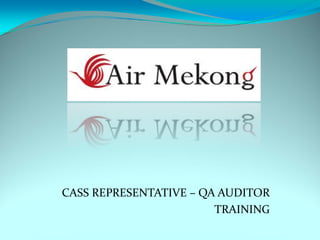Cass Rep
- 1. CASSÃ˝REPRESENTATIVEÃ˝‚Äì QAÃ˝AUDITOR TRAINING
- 2. GMMÃ˝3‚Äê4Ã˝ CONTINUOUSÃ˝ANALYSISÃ˝ ANDÃ˝SURVEILLANCEÃ˝ SYSTEM
- 3. CASS GMMÃ˝3‚Äê4.2Ã˝Ã˝SCOPEÃ˝Ã˝ ToÃ˝establishÃ˝andÃ˝maintainÃ˝aÃ˝systemÃ˝forÃ˝theÃ˝continuingÃ˝ analysisÃ˝andÃ˝surveillanceÃ˝ofÃ˝theÃ˝performanceÃ˝andÃ˝ effectivenessÃ˝ofÃ˝AirÃ˝Mekong‚ÄôsÃ˝inspectionÃ˝programÃ˝andÃ˝ programsÃ˝coveringÃ˝otherÃ˝maintenance,Ã˝preventiveÃ˝ maintenance,Ã˝andÃ˝alterations.
- 4. InspectionÃ˝andÃ˝MaintenanceÃ˝ Program TheÃ˝programÃ˝includesÃ˝theÃ˝BombardierÃ˝MIPÃ˝ asÃ˝wellÃ˝asÃ˝theÃ˝policiesÃ˝andÃ˝proceduresÃ˝inÃ˝theÃ˝GMMÃ˝ usedÃ˝forÃ˝complianceÃ˝withÃ˝theÃ˝VARs
- 5. CASS GMMÃ˝3‚Äê4.2Ã˝Ã˝SCOPEÃ˝ AND forÃ˝theÃ˝correctionÃ˝ofÃ˝anyÃ˝deficiencyÃ˝inÃ˝thoseÃ˝ programs,Ã˝regardlessÃ˝ofÃ˝whetherÃ˝thoseÃ˝programsÃ˝areÃ˝ carriedÃ˝outÃ˝byÃ˝AirÃ˝MekongÃ˝orÃ˝byÃ˝anotherÃ˝person.
- 6. Definitions QualityÃ˝AssuranceÃ˝andÃ˝CASSÃ˝Language
- 7. ContinuingÃ˝Ã˝Surveillance ContinuingÃ˝SurveillanceÃ˝meansÃ˝someoneÃ˝isÃ˝alwaysÃ˝ lookingÃ˝andÃ˝collectingÃ˝information
- 9. Correction AnÃ˝actionÃ˝designedÃ˝toÃ˝eliminateÃ˝orÃ˝mitigateÃ˝aÃ˝ deficiencyÃ˝identifiedÃ˝withinÃ˝theÃ˝maintenanceÃ˝programÃ˝ elements
- 10. Deficiency isÃ˝somethingÃ˝missingÃ˝fromÃ˝theÃ˝airÃ˝carrierÃ˝maintenanceÃ˝ programÃ˝thatÃ˝shouldÃ˝beÃ˝there, orÃ˝itÃ˝isÃ˝somethingÃ˝thereÃ˝butÃ˝notÃ˝producingÃ˝theÃ˝desiredÃ˝ results.
- 11. Effectiveness TheÃ˝maintenanceÃ˝programÃ˝isÃ˝producingÃ˝theÃ˝desiredÃ˝ results,Ã˝i.e.,Ã˝airworthyÃ˝aircraft,Ã˝competentÃ˝personnel,Ã˝ andÃ˝adequateÃ˝facilities.
- 12. Maintenance Inspection,Ã˝overhaul,Ã˝repair,Ã˝preservation,Ã˝andÃ˝theÃ˝ replacementÃ˝ofÃ˝parts,Ã˝excludingÃ˝preventiveÃ˝ maintenance
- 13. Responsibility TheÃ˝obligationÃ˝toÃ˝ensureÃ˝aÃ˝taskÃ˝orÃ˝functionÃ˝isÃ˝successfullyÃ˝ carriedÃ˝out. ResponsibilityÃ˝includesÃ˝accountingÃ˝forÃ˝actionsÃ˝relatedÃ˝toÃ˝ theÃ˝taskÃ˝orÃ˝function.Ã˝ThisÃ˝isÃ˝aÃ˝keyÃ˝attributeÃ˝ofÃ˝ operationalÃ˝control.
- 14. Risk RiskÃ˝isÃ˝theÃ˝degreeÃ˝ofÃ˝probabilityÃ˝hurt,Ã˝injury,Ã˝orÃ˝lossÃ˝willÃ˝ occurÃ˝overÃ˝aÃ˝specificÃ˝periodÃ˝ofÃ˝timeÃ˝orÃ˝numberÃ˝ofÃ˝ operationalÃ˝cycles. RiskÃ˝hasÃ˝twoÃ˝elements,Ã˝severity andÃ˝likelihood
- 16. Likelihood LikelihoodÃ˝isÃ˝aÃ˝qualitativeÃ˝expressionÃ˝ofÃ˝theÃ˝probabilityÃ˝aÃ˝ specificÃ˝unsafeÃ˝eventÃ˝willÃ˝occur.
- 17. ManagerÃ˝‚Äê QualityÃ˝AssuranceÃ˝orÃ˝hisÃ˝ Designee ManagerÃ˝‚Äê QualityÃ˝Assurance,Ã˝orÃ˝designee,Ã˝isÃ˝responsibleÃ˝ forÃ˝theÃ˝following:
- 18. Responsibilities EvaluatingÃ˝andÃ˝analyzingÃ˝auditsÃ˝andÃ˝operationsÃ˝dataÃ˝ inputÃ˝intoÃ˝theÃ˝CASSÃ˝DatabaseÃ˝onÃ˝aÃ˝day‚Äêto‚Äêday,Ã˝longÃ˝ termÃ˝andÃ˝emergencyÃ˝basis.
- 20. CASSÃ˝DATAÃ˝BASEÃ˝Ã˝GMMÃ˝3‚Äê5.7 TheÃ˝databaseÃ˝systemÃ˝consistsÃ˝ofÃ˝multipleÃ˝databasesÃ˝ maintainedÃ˝byÃ˝CASSÃ˝andÃ˝QA.Ã˝TheseÃ˝databasesÃ˝mayÃ˝beÃ˝ locatedÃ˝onÃ˝theÃ˝companyÃ˝intranetÃ˝orÃ˝throughÃ˝licensingÃ˝ agreementsÃ˝withÃ˝thirdÃ˝partiesÃ˝throughÃ˝theÃ˝internet.Ã˝ TheÃ˝informationÃ˝containedÃ˝onÃ˝theseÃ˝databasesÃ˝isÃ˝solelyÃ˝ controlledÃ˝byÃ˝AirÃ˝MekongÃ˝CASSÃ˝Ã˝andÃ˝QA.Ã˝ContentsÃ˝ include,Ã˝butÃ˝areÃ˝notÃ˝limitedÃ˝to: ‚Ä¢Ã˝AuditÃ˝Checklists ‚Ä¢Ã˝AuditÃ˝Schedules ‚Ä¢Ã˝ApprovedÃ˝VendorÃ˝Listing ‚Ä¢Ã˝AuditÃ˝ProgramÃ˝Database
- 21. CASSÃ˝DATABASEÃ˝Ã˝GMMÃ˝3‚Äê5.7 TheÃ˝informationÃ˝containedÃ˝inÃ˝theÃ˝databaseÃ˝isÃ˝ controlledÃ˝andÃ˝isÃ˝availableÃ˝toÃ˝allÃ˝membersÃ˝ofÃ˝CASSÃ˝andÃ˝ QA,Ã˝theÃ˝abilityÃ˝toÃ˝changeÃ˝theÃ˝informationÃ˝isÃ˝controlledÃ˝ byÃ˝theÃ˝ManagerÃ˝‚Äì AssuranceÃ˝orÃ˝designee.Ã˝ TheÃ˝informationÃ˝containedÃ˝inÃ˝theÃ˝databaseÃ˝andÃ˝ printoutsÃ˝ofÃ˝checklistsÃ˝areÃ˝madeÃ˝availableÃ˝toÃ˝theÃ˝CAAVÃ˝ orÃ˝otherÃ˝agenciesÃ˝withÃ˝aÃ˝validÃ˝requirement,Ã˝uponÃ˝ request.
- 22. OtherÃ˝Responsibilities MonitoringÃ˝andÃ˝trackingÃ˝CASSÃ˝activities.
- 24. Responsibilities AdministersÃ˝theÃ˝CASSÃ˝RepÃ˝Program
- 29. IRÃ˝DatabaseÃ˝EntriesÃ˝‚Äê NEW ERROR CONCERN HAZARD Quality Safety EVENT SUMMARY
- 30. IRÃ˝DatabaseÃ˝‚Äê DetailsÃ˝ DETAIL ACTION TAKEN
- 31. DataÃ˝BaseÃ˝EntriesÃ˝‚Äê Assign DropÃ˝ downÃ˝ box Assign Manager
- 33. AirÃ˝Mekong'sÃ˝CASS aÃ˝continuous,Ã˝systemÃ˝safetyÃ˝based,Ã˝closed‚ÄêloopÃ˝cycleÃ˝ofÃ˝ surveillance,Ã˝investigation,Ã˝dataÃ˝collection,Ã˝analysis,Ã˝ ActionÃ˝Taken,Ã˝monitoring,Ã˝andÃ˝feedbackÃ˝usedÃ˝toÃ˝ continuallyÃ˝monitorÃ˝andÃ˝correctÃ˝anyÃ˝deficienciesÃ˝inÃ˝AirÃ˝ Mekong‚ÄôsÃ˝maintenanceÃ˝and
- 34. AirÃ˝Mekong'sÃ˝CASS inspectionÃ˝programsÃ˝accomplishmentÃ˝andÃ˝approvalÃ˝ofÃ˝ maintenance,Ã˝including: InspectionÃ˝items AirworthinessÃ˝responsibility TheÃ˝CASSÃ˝program ContractÃ˝maintenance ManualÃ˝publicationÃ˝system MaintenanceÃ˝organization
- 36. ANY QUESTIONS?
- 37. TheÃ˝CASSÃ˝RepresentativeÃ˝(CASSÃ˝ Rep)Ã˝Program GivesÃ˝frontÃ˝lineÃ˝AirÃ˝MekongÃ˝MaintenanceÃ˝team membersÃ˝aÃ˝meansÃ˝toÃ˝provideÃ˝directÃ˝feedbackÃ˝onÃ˝issuesÃ˝ thatÃ˝affectÃ˝theirÃ˝abilityÃ˝toÃ˝performÃ˝theirÃ˝job.
- 39. TheÃ˝CASSÃ˝RepresentativeÃ˝(CASSÃ˝ Rep)Ã˝Program TheÃ˝inputÃ˝givenÃ˝isÃ˝reviewedÃ˝forÃ˝acceptanceÃ˝intoÃ˝theÃ˝ program,Ã˝andÃ˝thoseÃ˝itemsÃ˝acceptedÃ˝areÃ˝trackedÃ˝byÃ˝theÃ˝ ManagerÃ˝‚Äê QualityÃ˝AssuranceÃ˝andÃ˝evaluatedÃ˝toÃ˝ determineÃ˝aÃ˝courseÃ˝ofÃ˝actionÃ˝toÃ˝addressÃ˝theÃ˝issue.
- 40. TheÃ˝CASSÃ˝RepresentativeÃ˝(CASSÃ˝ Rep)Ã˝Program OnceÃ˝theÃ˝itemÃ˝hasÃ˝beenÃ˝resolvedÃ˝theÃ˝ManagerÃ˝‚Äê QualityÃ˝ AssuranceÃ˝willÃ˝follow‚ÄêupÃ˝withÃ˝theÃ˝originatorÃ˝toÃ˝ensureÃ˝ theyÃ˝areÃ˝awareÃ˝ofÃ˝theÃ˝actionsÃ˝thatÃ˝tookÃ˝place.
- 41. MonthlyÃ˝CASSÃ˝Report TheÃ˝ManagerÃ˝‚Äê QualityÃ˝AssuranceÃ˝publishes activeÃ˝issues,Ã˝withÃ˝status,Ã˝inÃ˝theÃ˝MonthlyÃ˝CASSÃ˝Report
- 43. Distribution CAAVÃ˝Ã˝Ã˝Ã˝Ã˝Ã˝Ã˝Ã˝Ã˝Ã˝Ã˝Ã˝Ã˝Ã˝Ã˝Ã˝Ã˝Ã˝Ã˝Ã˝Ã˝Ã˝Ã˝Ã˝Ã˝Ã˝Ã˝Ã˝Ã˝Ã˝Ã˝Ã˝Ã˝Ã˝Ã˝Ã˝Ã˝Ã˝Ã˝Ã˝Ã˝Ã˝Ã˝Ã˝Ã˝Ã˝Ã˝Ã˝Ã˝Ã˝Ã˝Ã˝Ã˝Ã˝Ã˝Ã˝Ã˝Ã˝Ã˝Ã˝Ã˝Ã˝Ho MinhÃ˝Tan CAAV MaiÃ˝Manh Hung ViceÃ˝PresidentÃ˝ofÃ˝Maintenance GaylonÃ˝Campbell DirectorÃ˝ofÃ˝Maintenance SteveÃ˝Banks DirectorÃ˝ofÃ˝QualityÃ˝andÃ˝Safety LeÃ˝NgocÃ˝Lam DirectorÃ˝ofÃ˝Corporate,Ã˝Safety/SecurityÃ˝Ã˝Ã˝Ã˝Ã˝Ã˝Ã˝Ã˝JeronimoÃ˝Chieccio ManagerÃ˝ofÃ˝QA RichardÃ˝Brown ManagerÃ˝ofÃ˝Spares BobbyÃ˝Maulding FleetÃ˝Manager BrianÃ˝Arett RecordsÃ˝Ã˝Ã˝Ã˝Ã˝Ã˝Ã˝Ã˝Ã˝Ã˝Ã˝Ã˝Ã˝Ã˝Ã˝Ã˝Ã˝Ã˝Ã˝Ã˝Ã˝Ã˝Ã˝Ã˝Ã˝Ã˝Ã˝Ã˝Ã˝Ã˝Ã˝Ã˝Ã˝Ã˝Ã˝Ã˝Ã˝Ã˝Ã˝Ã˝Ã˝Ã˝Ã˝Ã˝Ã˝Ã˝Ã˝Ã˝Ã˝Ã˝Ã˝Ã˝Ã˝Ã˝Ã˝Ã˝Ã˝Ã˝Ã˝Mary Maulding MCCÃ˝Ã˝Ã˝Ã˝Ã˝Ã˝Ã˝Ã˝Ã˝Ã˝Ã˝Ã˝Ã˝Ã˝Ã˝Ã˝Ã˝Ã˝Ã˝Ã˝Ã˝Ã˝Ã˝Ã˝Ã˝Ã˝Ã˝Ã˝Ã˝Ã˝Ã˝Ã˝Ã˝Ã˝Ã˝Ã˝Ã˝Ã˝Ã˝Ã˝Ã˝Ã˝Ã˝Ã˝Ã˝Ã˝Ã˝Ã˝Ã˝Ã˝Ã˝Ã˝Ã˝Ã˝Ã˝Ã˝Ã˝Ã˝Ã˝Ã˝Ã˝Ã˝Ã˝Ã˝DennisÃ˝Mollenhour HaÃ˝Noi SupÃ˝Ã˝Ã˝Ã˝Ã˝Ã˝Ã˝Ã˝Ã˝Ã˝Ã˝Ã˝Ã˝Ã˝Ã˝Ã˝Ã˝Ã˝Ã˝Ã˝Ã˝Ã˝Ã˝Ã˝Ã˝Ã˝Ã˝Ã˝Ã˝Ã˝Ã˝Ã˝Ã˝Ã˝Ã˝Ã˝Ã˝Ã˝Ã˝Ã˝Ã˝Ã˝Ã˝Ã˝Ã˝Ã˝Ã˝Ã˝Ã˝Ã˝Ã˝Ã˝Ã˝BobbyÃ˝MauldingÃ˝
- 44. CASSÃ˝ReportÃ˝TableÃ˝ofÃ˝Contents TheÃ˝dataÃ˝containedÃ˝inÃ˝thisÃ˝reportÃ˝reflectsÃ˝monthlyÃ˝ informationÃ˝fromÃ˝FebÃ˝11,Ã˝2011Ã˝‚Äì MarÃ˝10,Ã˝2011 ‚Ä¢Distribution ‚Ä¢OpenÃ˝CAAVÃ˝Issues ‚Ä¢OperationalÃ˝Data ‚Ä¢ReliabilityÃ˝Data ‚Ä¢AuditÃ˝ProgramÃ˝Data ‚Ä¢OpenÃ˝CASSÃ˝InvestigationÃ˝Information ‚Ä¢OpenÃ˝CASSÃ˝RepresentativeÃ˝ProgramÃ˝ Information ‚Ä¢OpenÃ˝CASSÃ˝Initiatives ‚Ä¢MEDAÃ˝Investigations ‚Ä¢Trending/AnalysisÃ˝(Quarterly)
- 46. MonthlyÃ˝CASSÃ˝ReportÃ˝‚Äì ResultsÃ˝ofÃ˝ AuditsÃ˝ofÃ˝Processes.Ã˝ ThisÃ˝processÃ˝isÃ˝auditedÃ˝perÃ˝GMMÃ˝3‚Äê5.Ã˝TheÃ˝resultsÃ˝ofÃ˝ theÃ˝auditÃ˝areÃ˝inputÃ˝intoÃ˝theÃ˝CASSÃ˝databaseÃ˝forÃ˝analysisÃ˝ andÃ˝usedÃ˝toÃ˝evaluateÃ˝theÃ˝processÃ˝forÃ˝COMPLIANCEÃ˝ TOÃ˝THEÃ˝REGULATIONSÃ˝ANDÃ˝COMPANYÃ˝POLICY.Ã˝Ã˝ TrendÃ˝analysisÃ˝isÃ˝accomplishedÃ˝toÃ˝determineÃ˝ifÃ˝ NEGATIVEÃ˝TRENDSÃ˝haveÃ˝anÃ˝affectÃ˝onÃ˝otherÃ˝areasÃ˝ofÃ˝ theÃ˝operation.Ã˝IndividualÃ˝negativeÃ˝resultsÃ˝areÃ˝analyzedÃ˝ andÃ˝usedÃ˝toÃ˝developÃ˝processÃ˝improvements.
- 47. CASSÃ˝Representative EveryÃ˝maintenanceÃ˝station/baseÃ˝shouldÃ˝haveÃ˝atÃ˝leastÃ˝oneÃ˝ individualÃ˝thatÃ˝hasÃ˝beenÃ˝trainedÃ˝onÃ˝theÃ˝CASSÃ˝RepÃ˝ ProgramÃ˝andÃ˝isÃ˝willing toÃ˝assistÃ˝theÃ˝ManagerÃ˝‚Äê QualityÃ˝ AssuranceÃ˝withÃ˝gatheringÃ˝informationÃ˝atÃ˝thatÃ˝station.
- 48. CASSÃ˝Representative ItemsÃ˝canÃ˝beÃ˝givenÃ˝toÃ˝thatÃ˝CASSÃ˝RepresentativeÃ˝andÃ˝theyÃ˝ willÃ˝forwardÃ˝itÃ˝toÃ˝theÃ˝ManagerÃ˝‚Äê QualityÃ˝Assurance.
- 50. ANYÃ˝QUESTIONS??????? ACCEPTABLE MAINTENANCE PRACTICE?
- 51. StandardÃ˝OperatingÃ˝ProcedureÃ˝ 4003Ã˝Ã˝Ã˝QualityÃ˝AssuranceÃ˝(QA) ProvidesÃ˝instructionsÃ˝andÃ˝proceduresÃ˝forÃ˝QualityÃ˝ AssuranceÃ˝(QA)Ã˝relatedÃ˝inquiresÃ˝andÃ˝assessmentsÃ˝ofÃ˝ events,Ã˝processesÃ˝and/orÃ˝programs.
- 52. StandardÃ˝OperatingÃ˝ProcedureÃ˝ 4003Ã˝Ã˝QualityÃ˝AssuranceÃ˝(QA) AirÃ˝MekongÃ˝utilizesÃ˝auditorsÃ˝toÃ˝gatherÃ˝dataÃ˝forÃ˝theÃ˝CASSÃ˝ programÃ˝(GMMÃ˝3‚Äê4)Ã˝fromÃ˝theÃ˝MaintenanceÃ˝Bases/LineÃ˝ Stations,Ã˝Shops,Ã˝andÃ˝MaintenanceÃ˝andÃ˝ServiceÃ˝ Providers
- 53. GatheringÃ˝DataÃ˝‚Äì HowÃ˝doÃ˝wo doÃ˝ that? AUDITÃ˝CHECKLISTS TheÃ˝AuditÃ˝RequirementÃ˝MasterÃ˝isÃ˝anÃ˝ExcelÃ˝spreadÃ˝sheetÃ˝ blankÃ˝usedÃ˝forÃ˝buildingÃ˝auditÃ˝requirementsÃ˝usingÃ˝ regulatoryÃ˝material,Ã˝AirÃ˝MekongÃ˝policiesÃ˝andÃ˝ proceduresÃ˝orÃ˝otherÃ˝standardsÃ˝andÃ˝specifications. AuditÃ˝RequirementÃ˝Master,Ã˝M‚Äê430
- 55. DevelopingÃ˝anÃ˝Audit NotÃ˝anÃ˝InspectionÃ˝ofÃ˝piecesÃ˝andÃ˝partsÃ˝butÃ˝anÃ˝analysisÃ˝ usingÃ˝theÃ˝elementsÃ˝ofÃ˝a: Standard Specification Procedure Process
- 56. DevelopingÃ˝anÃ˝Audit GMMÃ˝3‚Äê19.6.C.Ã˝TechnicalÃ˝RecordsÃ˝Security:Ã˝CurrentÃ˝ recordsÃ˝areÃ˝storedÃ˝andÃ˝maintainedÃ˝inÃ˝theÃ˝officeÃ˝ofÃ˝ TechnicalÃ˝RecordsÃ˝Department.Ã˝HistoricalÃ˝recordsÃ˝areÃ˝ keptÃ˝inÃ˝aÃ˝storageÃ˝boxÃ˝byÃ˝aircraftÃ˝tailÃ˝numberÃ˝atÃ˝aÃ˝ designatedÃ˝secureÃ˝storageÃ˝area.Ã˝TheÃ˝officeÃ˝ofÃ˝TechnicalÃ˝ RecordsÃ˝isÃ˝openÃ˝onlyÃ˝whenÃ˝businessÃ˝isÃ˝beingÃ˝ conducted.Ã˝DuringÃ˝non‚ÄêbusinessÃ˝hours,Ã˝theÃ˝TechnicalÃ˝ RecordsÃ˝filingÃ˝roomÃ˝isÃ˝securedÃ˝andÃ˝locked.Ã˝InÃ˝theÃ˝eventÃ˝ anÃ˝aircraftÃ˝recordÃ˝isÃ˝reportedÃ˝asÃ˝aÃ˝transactionÃ˝error;Ã˝aÃ˝ copyÃ˝ofÃ˝theÃ˝documentÃ˝isÃ˝sentÃ˝forÃ˝correctionÃ˝andÃ˝theÃ˝ originalÃ˝residesÃ˝inÃ˝theÃ˝appropriateÃ˝fileÃ˝untilÃ˝theÃ˝ correctedÃ˝paperworkÃ˝isÃ˝received.
- 57. DevelopingÃ˝anÃ˝Audit 1.Ã˝Ã˝CurrentÃ˝recordsÃ˝areÃ˝storedÃ˝andÃ˝maintainedÃ˝inÃ˝theÃ˝ officeÃ˝ofÃ˝TechnicalÃ˝RecordsÃ˝Department. 2.Ã˝HistoricalÃ˝recordsÃ˝areÃ˝keptÃ˝inÃ˝aÃ˝storageÃ˝boxÃ˝byÃ˝aircraftÃ˝ tailÃ˝numberÃ˝atÃ˝aÃ˝designatedÃ˝secureÃ˝storageÃ˝area. 3.Ã˝TheÃ˝officeÃ˝ofÃ˝TechnicalÃ˝RecordsÃ˝isÃ˝openÃ˝onlyÃ˝whenÃ˝ businessÃ˝isÃ˝beingÃ˝conducted.Ã˝ 4.Ã˝DuringÃ˝non‚ÄêbusinessÃ˝hours,Ã˝theÃ˝TechnicalÃ˝RecordsÃ˝ filingÃ˝roomÃ˝isÃ˝securedÃ˝andÃ˝locked. 5.Ã˝InÃ˝theÃ˝eventÃ˝anÃ˝aircraftÃ˝recordÃ˝isÃ˝reportedÃ˝asÃ˝aÃ˝ transactionÃ˝error;Ã˝aÃ˝copyÃ˝ofÃ˝theÃ˝documentÃ˝isÃ˝sentÃ˝forÃ˝ correctionÃ˝andÃ˝theÃ˝originalÃ˝residesÃ˝inÃ˝theÃ˝appropriateÃ˝ fileÃ˝untilÃ˝theÃ˝correctedÃ˝paperworkÃ˝isÃ˝received.
- 58. M‚Äê430Ã˝Ã˝Development GMMÃ˝ Reference GMMÃ˝TextÃ˝ element COMPLIANCE Finding AuditÃ˝FindingÃ˝ ReportÃ˝NumberÃ˝ andÃ˝Notes
- 62. InterviewingÃ˝‚Äì TheÃ˝Answers AnyÃ˝answerÃ˝"no"Ã˝toÃ˝aÃ˝ requiredÃ˝stepÃ˝isÃ˝aÃ˝ FINDING.Ã˝
- 64. InterviewingÃ˝‚Äì TheÃ˝Answers AnyÃ˝failureÃ˝toÃ˝followÃ˝theÃ˝ process,Ã˝procedure,Ã˝useÃ˝ theÃ˝requiredÃ˝ documentation,Ã˝etc.Ã˝isÃ˝aÃ˝ FINDING
- 65. InterviewingÃ˝‚Äì TheÃ˝Answers AnyÃ˝elementÃ˝ofÃ˝aÃ˝procedureÃ˝ orÃ˝processÃ˝thatÃ˝isÃ˝vagueÃ˝andÃ˝ allowsÃ˝forÃ˝aÃ˝performanceÃ˝ error,Ã˝aÃ˝stepÃ˝thatÃ˝canÃ˝notÃ˝beÃ˝ confirmedÃ˝toÃ˝beÃ˝completed,Ã˝ isÃ˝alsoÃ˝aÃ˝FINDING
- 66. ROOTÃ˝CAUSE FindingÃ˝theÃ˝FindingÃ˝isÃ˝easy.Ã˝Ã˝ FindingÃ˝theÃ˝Why takesÃ˝ moreÃ˝time.
- 70. OUTBRIEFÃ˝MANAGER 1.Ã˝Ã˝Discuss findingsÃ˝withÃ˝Manager 2.Ã˝Ã˝MakeÃ˝anÃ˝effortÃ˝toÃ˝agreeÃ˝onÃ˝ whichÃ˝itemsÃ˝areÃ˝findings 3.Ã˝Ã˝QAÃ˝findingsÃ˝inÃ˝disputeÃ˝shouldÃ˝ beÃ˝referredÃ˝toÃ˝QAÃ˝Manager.
- 71. On‚ÄêThe‚ÄêSpotÃ˝CorrectiveÃ˝Actions OnÃ˝theÃ˝spotÃ˝correctiveÃ˝actionsÃ˝ areÃ˝stillÃ˝findingsÃ˝andÃ˝mustÃ˝beÃ˝ reported. OnÃ˝TheÃ˝SpotÃ˝correctiveÃ˝actionsÃ˝ shallÃ˝beÃ˝identifiedÃ˝asÃ˝suchÃ˝andÃ˝ putÃ˝inÃ˝theÃ˝QAÃ˝FindingÃ˝TrackerÃ˝ asÃ˝CLOSED.
- 73. AuditÃ˝FindingÃ˝Report Location,Ã˝FunctionÃ˝Date,Ã˝ Sequence Data,Ã˝Specification,Ã˝GMMÃ˝and/orÃ˝ AuditÃ˝Req Reference. FindingÃ˝‚Äì fromÃ˝AuditÃ˝Form AuditorÃ˝orÃ˝CASSÃ˝Rep
- 74. REPORTING ScanÃ˝andÃ˝emailÃ˝everythingÃ˝toÃ˝ QAÃ˝ManagerÃ˝orÃ˝QAÃ˝AuditorÃ˝ MissÃ˝Men
- 81. Questions
- 82. THEÃ˝END

































































































































